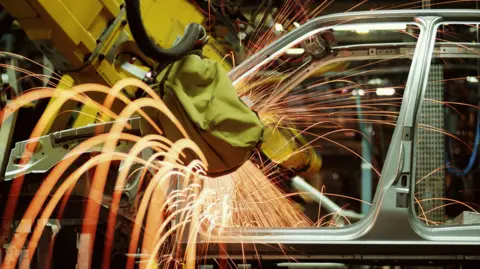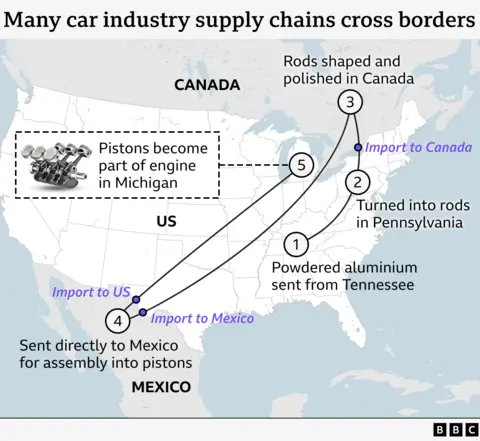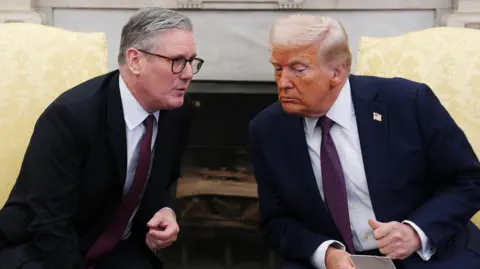US President Donald Trump has announced a universal “baseline” 10% tariff on imports into the US, on what he has dubbed “Liberation Day”.
Describing 2 April, 2025 as “our declaration of America’s economic independence”, he said “reciprocal tariffs” would start at that baseline, although 60 countries would be hit with far higher rates of up to 50%.
The tariffs will take effect in the next few days.
Trump said that from midnight on 3 April, the US would start imposing 25% tariffs on all foreign-made cars. It is unclear if this was additional to the universal tariffs.
Trump argues the measures – which make foreign goods more expensive – will help US manufacturers and protect jobs. However, prices could go up for consumers.
What tariffs has Trump just announced?
Trump said that the US had been taken advantage of by “cheaters” and “pillaged” by foreigners and announced a 10% “baseline” tariff on all imports coming into the US.
However, nations including Cambodia, Vietnam, Malaysia and Bangladesh will be hit much harder, with tariffs reaching 50% in some cases.
UK goods will be hit by a 10% tariff, while those from the 27-member EU bloc by 20%.
The baseline 10% tariff will kick in on 5 April 12:01EST, while higher rates starting from 12:01 EST on 9 April.
Trump has previously announced a 25% tariff on all foreign-made cars coming into the US, which takes effect at midnight EST (04:00 GMT) 3 April.
Last month, he hadunveiled a 25% tariff on all steel and aluminium imports.
The US president had also doubled to 20% a tariff on Chinese goods, slapped 25% on goods from Mexico and Canada, and a 10% tariff on Canadian energy imports.
What are tariffs and how do they work?
Tariffs are taxes charged on goods imported from other countries.
Typically, tariffs are a percentage of a product’s value. For example, a 25% tariff on a $10 (£7.76) product would mean an additional $2.50 charge.
Companies that bring the foreign goods into the country have to pay the tax to the government.
Firms can choose to pass on some or all of the cost to customers.
The universal “reciprocal tariffs” announced by Trump are meant to target rival countries that are already placing import charges on American products – although the US president argues his levies are smaller than those imposed on the US.
 Getty
GettyWhy is Trump using tariffs?
Tariffs are a central part of Trump’s economic vision. He says “tariff” is his favourite word.
He argues the taxes will encourage US consumers to buy more American-made goods, boosting the country’s economy and increasing the amount of tax raised.
Trump wants to reduce the gap between the value of goods the US imports and those it exports to other countries.
For example, the US had a trade deficit of $213bn (£165bn) with the European Union (EU) in 2024, something Trump has called “an atrocity”.
The US president also said tariffs were intended to force China, Mexico and Canada – the countries first targeted – to do more to stop migrants and drugs reaching the US.
He has refused to rule out the possibility of a recession as a result of his trade policies. US Commerce Secretary Howard Lutnick said tariffs were “worth it” even if they led to an economic downturn.
Several tariffs announced by Trump have subsequently been delayed, amended or scrapped.
Will prices go up for US consumers?
Economists expect tariffs to increase prices for US consumers across many imported goods, as firms pass on some or all of their increased costs.
The products affected could include everything from beer, whisky and tequila to maple syrup, fuel and avocados.
Firms may also decide to import fewer foreign goods, which could in turn make those which are available more expensive.
Among Trump’s targets are overseas car firms. The US imported about eight million cars last year – accounting for about $240bn (£186bn) in trade and roughly half of overall sales.
The new import taxes of 25% on cars and car parts will take effect on 2 April, with charges on businesses importing vehicles starting the next day. Taxes on parts are due to kick in later, possibly in May.
Car prices were already expected to rise as a result of tariffs on imports from Canada and Mexico.
Component parts typically cross the US, Mexican and Canadian borders multiple times before a vehicle is completely assembled.

The cost of a car made using parts from Mexico and Canada alone could rise by $4,000-$10,000 depending on the vehicle, according to analysts at the Anderson Economic Group.
The tariffs Trump announced during his first term as president raised the average price of steel and aluminium in the US by 2.4% and 1.6% respectively, according to the US International Trade Commission.
US tariffs on imported washing machines between 2018 and 2023 increased the price of laundry equipment by 34%, according to official statistics.
Prices fell once the tariffs expired.
How will Trump’s tariffs affect the UK?
 PA Media
PA MediaHow have other countries responded to Trump’s tariffs?
A number of other countries have introduced their own tariffs on goods imported from the US.
These will make US products more expensive, and are bolstering fears of a global trade war which could create problems for economies worldwide.
China has introduced a 10-15% tax on some US agricultural goods. It has also targeted US aviation, defence and tech firms.
EU tariffs targeting US goods worth €26bn (£22bn) will start on 1 April and be fully in place on 13 April. They will cover items ranging “from boats to bourbon to motorbikes”, as well as steel and aluminium products.
The head of the European Commission, Ursula von der Leyen, has promised a “robust and calibrated response” to any further tariff announcements.
Canada has imposed 25% tariffs on US steel, aluminium and a range of other goods. Further counter tariffs may be introduced.
Mexico has delayed introducing its own retaliatory tariffs while negotiations continue.



